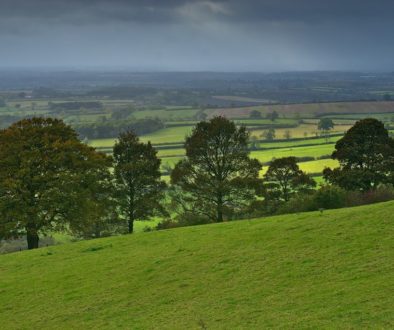Whose rural-urban fringe?
Land is one of our greatest assets, providing us with basic services, underpinning the economy and highlighting national identity and cultural heritage.
Yet the ‘rural-urban fringe’ – the countryside immediately around our towns and cities – has all-too-often been a neglected and wasted resource. With increasing demands being placed upon land, can we afford to overlook the potential of the ‘fringe’? Jessica Sellick investigates.
The rural-urban fringe – often referred to as the ‘outskirts’, a ‘hinterland’, ‘green land surrounding a built up area’, ‘on the edge of a settlement’ or ‘open land’ – is the landscape interface between town and country. Considered to be a transition zone where urban and rural uses interact (and complement or conflict) or as a separate landscape type in its own right; these areas are often administratively fragmented with no distinct identity leading to their neglect and undervalue.
Yet these areas are also under intense development pressure compounded by an inconsistent approach to growth, expansion and planning policy. Amid this lack of functional integrity, are there opportunities to realise the fringe as an asset for the purposes of highlighting urban and rural connectivities? How can we make the fringe not only an attractive and valued asset but also reconcile the pressures it is under? How can the ‘fringe’ ‘pay its way’ and become a site of investment and innovation? I offer three points.
Firstly, interest in the rural-urban fringe from policy and decision makers in the UK can be traced back to ‘unlocking the potential of the rural urban fringe‘, a consultation document published in 2004 by the Countryside Agency and Groundwork. The then chair of the Countryside Agency, Sir Ewan Cameron, stated: “Now is the time to make major and long-term improvements to the urban-rural fringe. At the moment this countryside is all too often badly planned and badly managed making it unattractive and neglected, it is a wasted asset.” The consultation took up the Government’s Urban White Paper (2000) and Sustainable Communities Plan (2003) to call for a strengthened relationship between town and country.
Regional Spatial Strategies, Local Development Frameworks and Community Strategies were all intended to unlock that potential and coordinate policies and actions at sub-regional and local levels. In 2005, the Countryside Agency and Groundwork followed this up with a ‘Vision’ for developing the ‘Countryside In and Around Towns‘ (CIAT). This publication outlined the importance of these multifunctional spaces and subsequently became a Programme of work within Natural England featuring demonstration examples and projects to meet the demand for countryside on the doorstep of towns.
In recent years there has been renewed interest in how the full economic, environmental and social potential of the rural-urban fringe can be unlocked. At an international level, the Organisation for Economic Co-operation and Development’s (OECD) “Rurban” Project is assessing the role of partnerships in responding to the specific needs of urban and rural areas and determining whether these arrangements should be further supported through public policies and/or regional rural policy instruments. Of particular relevance to RSN readers, the OECD’s analysis will assess rural-urban linkages around public service delivery, environmental services and infrastructure. The OECD is due to launch its findings and recommendations in October 2013.
At a European level, the Sustainable Urban Fringes (SURF) project has brought together partners from across the North Sea Region to exchange information and develop a common approach towards the sustainability of urban fringe areas. Taking place between 2009 and 2012, UK partners in the project include Aberdeen City Council, Leeds Metropolitan University, Norfolk County Council and Bradford Metropolitan District Council (Airedale Partnership). Key initiatives have included a review of urban fringe policies and a set of policy guidelines to tackle issues of governance and spatial planning. In 2011, Rose Regeneration worked with communities in the Worth Valley (on behalf of the Airedale Partnership) to help them think through their contribution to the competitiveness of the Leeds City Region and wider Yorkshire Region.
This was about creating synergies in an urban fringe context (e.g. around spatial planning, the environment) to help the community produce a meaningful Parish Plan. On 4 October 2012, the Airedale Partnership and Leeds Metropolitan University will host a conference entitled: ‘Localism beyond the City in a City Region Context – How can the urban/rural fringe progress in challenging times?’ The event will offer insights into the SURF project and how the rural-urban fringe might fare in the future (for more information please contact Saiqa Ramzan: saiqa.ramzan@bradford.gov.uk).
Secondly, the fringe has become a site of public interest and debate. Under the strap line ‘stop them taking bites from your countryside’, the Campaign for the Protection of Rural England (CPRE) launched a briefing and map in August 2012 to draw attention to the major threats to England’s green belts. The threats include proposals for over 80,000 new homes over the next twenty years. According to Paul Miner at CPRE: “the green belt helps regenerate our cities and stops them sprawling into rural areas.
As a result, no one is ever too far from true, green English countryside… It is vital that the Government steps in to ensure…investment and development within existing urban areas, rather than allowing the unnecessary loss of green belt land”. Yet ‘Cities for Growth‘, a report from Policy Exchange (2011) suggests green belts stifle our cities by protecting peripheral and low-quality land, whilst forcing development into really rural areas and cramming more and more into already packed cities.
In an academic context, Birmingham City University has been leading a research project on behalf of the Rural Economy and Land Use Programme (RELU) labelled ‘managing environmental change at the rural-urban fringe‘. This is looking at how spatial planning and ecosystem services can be used to identify management issues and needs.
Thirdly, and against this backdrop, there are already a plethora of tried and tested approaches to managing the rural-urban fringe. The Community Forest programme, established in 1990 by the then Countryside Commission, delivers a comprehensive package of regeneration to create high quality environments for people. Each of the 12 Community Forests is a partnership between local authorities and local, regional and national players. Community Forests have been financially independent since 2007 and rely upon a variety of sources of income to continue.
In June 2011, the Government launched ‘the natural choice’, the first Natural Environment White Paper (NEWP) in 20 years, outlining the Government’s vision for the next 50 years. The NEWP shifts thinking away from viewing nature as a series of disconnected places (or isolated spots of green on a map) to one of a thriving green network linking farmland, forestry, urban parks and gardens. Rose Regeneration supported Pennine Prospects with its application for the South Pennines to become a LNP (approved by Defra in July 2012).
Lying between the Peak District National Park, the Yorkshire Dales National Park and Nidderdale AONB, at the heart of three city regions (Greater Manchester, Leeds and Pennine Lancashire) and in an undesignated landscape; the South Pennines LNP will raise awareness of the services and benefits that the natural environment provides to the 450,000 people who live and work in the local area and the 7 million people that live within an hour’s drive. In this way, the LNP is utilising existing good practice such as Incredible Edible Todmorden (IET), a community group which grows and campaigns for local food. IET works on green field sites to create more growing and learning spaces and on donated land to develop ideas about hill-top farming.
Environment Minister Richard Benyon has described how “green spaces are not only important for our health and well-being; they also create places where people want to invest, generating new jobs and businesses”. With the Government committed to (economic) growth, localism, the big society, natural environment and planning reform; what are the untapped potential, possible pitfalls and emerging opportunities for the rural-urban fringe? How can we heed Sir Ewan Cameron’s warning and ensure that the fringe is not a “wasted asset”?
How can the fringe be viewed as an exciting landscape space fit for the 21st century? To explore the issues raised here further, the Rural Services Network is holding an event on 11 October 2012 at St Mary’s Church in Sheffield. The event, “perceptions of the urban fringe – an integrated vision?” will include presentations from the Airedale Partnership (regarding the SURF project), Pennine Prospects (outlining their regeneration work between cities), the NFU (on new opportunities for agriculture) and the Villages and Communities Together Project (Peak District National Park). For more information and to book your place at this free event please contact Wendy Cooper by email wendy.cooper@sparse.gov.uk or telephone 01822 813693.
Jessica has undertaken a variety of projects on land management and rural economies. These include: preparing the Yorkshire Dales Local Food Map (celebrating the distinctiveness of the Dales landscape); considering how the Common Agricultural Policy (CAP) can be reformed to benefit rural communities; and supporting community groups in understanding natural resource management. For more information about Rose Regeneration’s work please contact Jessica by email jessica.sellick@roseregeneration.co.uk or telephone 01522 521211.


